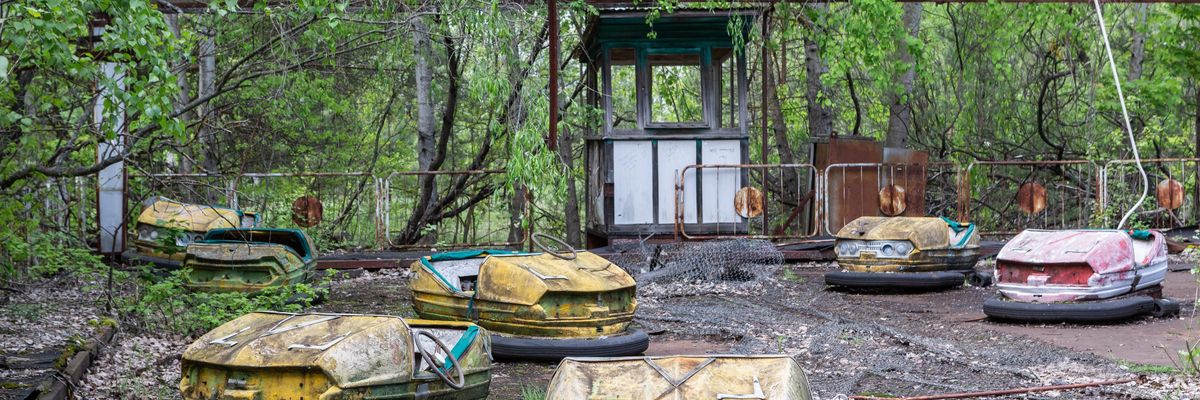
Abandoned bumper cars full of rust sit in an amusement park in the ghost city of Pripyat, Ukraine, which was evacuated on the afternoon of April 27, 1986, 36 hours after the Chernobyl Nuclear Power Plant disaster. (Photo: Francisco Goncalves/Getty Images)
In Ukraine, Nuclear Catastrophe Looms
Instead of focusing on who is to blame for creating this dire situation, Ukraine, Russia, and the international community need to work together to figure out how to stem the danger of a strike on Zaporizhzhia or its supporting safety systems.
The United Nations' top nuclear official this week warned about the "very alarming" military activity surrounding the Zaporizhzhia nuclear facility just across the Dnipro River from the southern city of Nikopol. Russian forces seized control of the site--the largest nuclear plant in Europe--in March and are accused of using it as a shield and a base to launch rocket attacks.
Rafael Mariano Grossi, head of the International Atomic Energy Agency, last week called the situation "completely out of control" and is now urging both Ukraine and Russia to halt any fighting near the facility that has "even the smallest potential to jeopardize nuclear safety."
Indeed, the continued fighting and shelling surrounding Zaporizhzhia risks sparking a nuclear disaster that could impact thousands of Ukrainians and Russians through displacement and radiation dangers that will have health impacts for years or decades to come.
Ukraine and Russia must reach an agreement now that permits international inspectors onto the site to ensure its stability and security, and, ideally, creates a "safe zone" around the perimeter to prevent attacks that come close to the reactors or their safety systems.
Instead of focusing on who is to blame for creating this dire situation, Ukraine, Russia, and the international community need to work together to figure out how to stem the danger of a strike on the plant or its supporting safety systems. So long as this war continues, risks of catastrophic actions, accidents, and escalations will remain, and will threaten people on both sides of the war's continually shifting lines between Russia and Ukraine.
This crisis further underscores the vital importance of diplomacy --even, and perhaps especially, at a time of intense fighting in Ukraine. The United States will play a central role in any eventual peace settlement, and bringing about such an agreement should be a top priority for U.S. officials.
The alternative is the continuation of a lengthy, volatile war that risks additional, massive suffering and possible escalation into a direct U.S.-Russia or NATO-Russia conflict, with all the dangers that entails.
An Urgent Message From Our Co-Founder
Dear Common Dreams reader, The U.S. is on a fast track to authoritarianism like nothing I've ever seen. Meanwhile, corporate news outlets are utterly capitulating to Trump, twisting their coverage to avoid drawing his ire while lining up to stuff cash in his pockets. That's why I believe that Common Dreams is doing the best and most consequential reporting that we've ever done. Our small but mighty team is a progressive reporting powerhouse, covering the news every day that the corporate media never will. Our mission has always been simple: To inform. To inspire. And to ignite change for the common good. Now here's the key piece that I want all our readers to understand: None of this would be possible without your financial support. That's not just some fundraising cliche. It's the absolute and literal truth. We don't accept corporate advertising and never will. We don't have a paywall because we don't think people should be blocked from critical news based on their ability to pay. Everything we do is funded by the donations of readers like you. Will you donate now to help power the nonprofit, independent reporting of Common Dreams? Thank you for being a vital member of our community. Together, we can keep independent journalism alive when it’s needed most. - Craig Brown, Co-founder |
The United Nations' top nuclear official this week warned about the "very alarming" military activity surrounding the Zaporizhzhia nuclear facility just across the Dnipro River from the southern city of Nikopol. Russian forces seized control of the site--the largest nuclear plant in Europe--in March and are accused of using it as a shield and a base to launch rocket attacks.
Rafael Mariano Grossi, head of the International Atomic Energy Agency, last week called the situation "completely out of control" and is now urging both Ukraine and Russia to halt any fighting near the facility that has "even the smallest potential to jeopardize nuclear safety."
Indeed, the continued fighting and shelling surrounding Zaporizhzhia risks sparking a nuclear disaster that could impact thousands of Ukrainians and Russians through displacement and radiation dangers that will have health impacts for years or decades to come.
Ukraine and Russia must reach an agreement now that permits international inspectors onto the site to ensure its stability and security, and, ideally, creates a "safe zone" around the perimeter to prevent attacks that come close to the reactors or their safety systems.
Instead of focusing on who is to blame for creating this dire situation, Ukraine, Russia, and the international community need to work together to figure out how to stem the danger of a strike on the plant or its supporting safety systems. So long as this war continues, risks of catastrophic actions, accidents, and escalations will remain, and will threaten people on both sides of the war's continually shifting lines between Russia and Ukraine.
This crisis further underscores the vital importance of diplomacy --even, and perhaps especially, at a time of intense fighting in Ukraine. The United States will play a central role in any eventual peace settlement, and bringing about such an agreement should be a top priority for U.S. officials.
The alternative is the continuation of a lengthy, volatile war that risks additional, massive suffering and possible escalation into a direct U.S.-Russia or NATO-Russia conflict, with all the dangers that entails.
The United Nations' top nuclear official this week warned about the "very alarming" military activity surrounding the Zaporizhzhia nuclear facility just across the Dnipro River from the southern city of Nikopol. Russian forces seized control of the site--the largest nuclear plant in Europe--in March and are accused of using it as a shield and a base to launch rocket attacks.
Rafael Mariano Grossi, head of the International Atomic Energy Agency, last week called the situation "completely out of control" and is now urging both Ukraine and Russia to halt any fighting near the facility that has "even the smallest potential to jeopardize nuclear safety."
Indeed, the continued fighting and shelling surrounding Zaporizhzhia risks sparking a nuclear disaster that could impact thousands of Ukrainians and Russians through displacement and radiation dangers that will have health impacts for years or decades to come.
Ukraine and Russia must reach an agreement now that permits international inspectors onto the site to ensure its stability and security, and, ideally, creates a "safe zone" around the perimeter to prevent attacks that come close to the reactors or their safety systems.
Instead of focusing on who is to blame for creating this dire situation, Ukraine, Russia, and the international community need to work together to figure out how to stem the danger of a strike on the plant or its supporting safety systems. So long as this war continues, risks of catastrophic actions, accidents, and escalations will remain, and will threaten people on both sides of the war's continually shifting lines between Russia and Ukraine.
This crisis further underscores the vital importance of diplomacy --even, and perhaps especially, at a time of intense fighting in Ukraine. The United States will play a central role in any eventual peace settlement, and bringing about such an agreement should be a top priority for U.S. officials.
The alternative is the continuation of a lengthy, volatile war that risks additional, massive suffering and possible escalation into a direct U.S.-Russia or NATO-Russia conflict, with all the dangers that entails.

